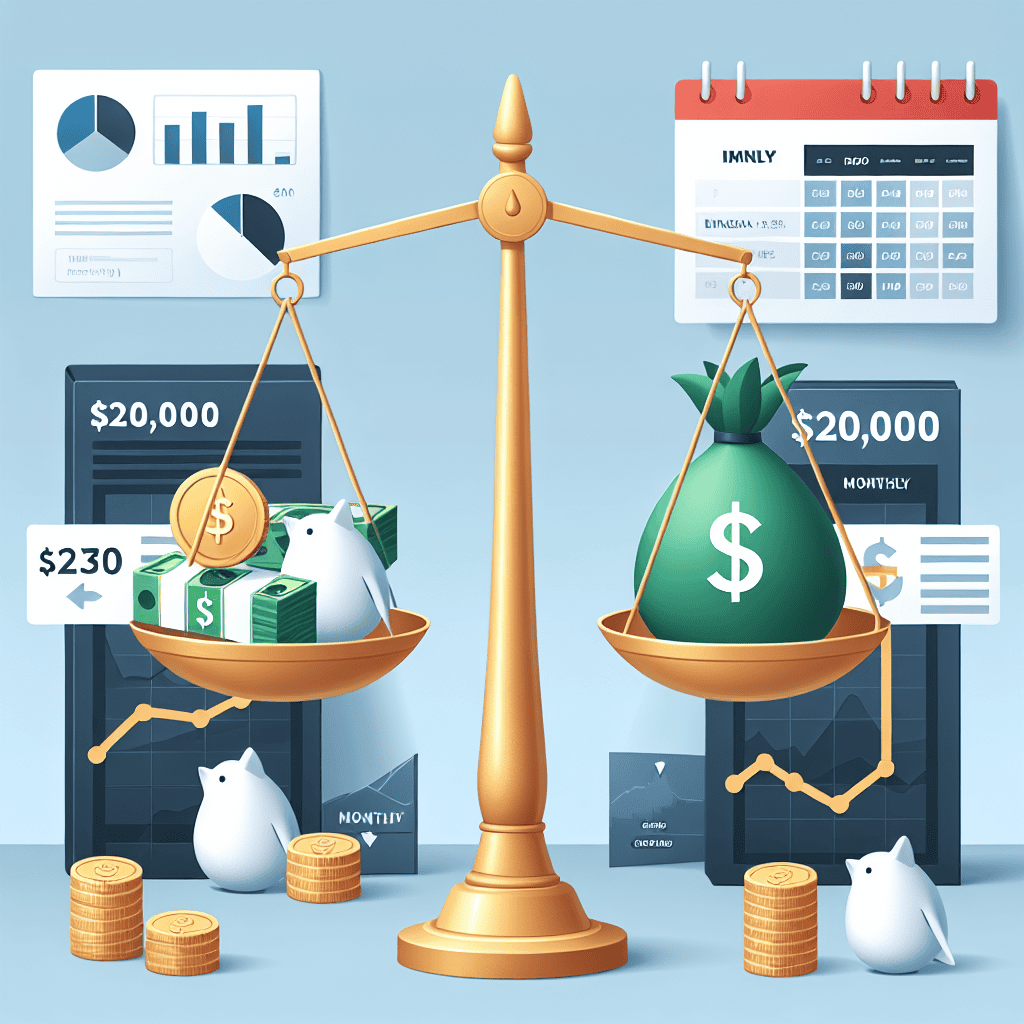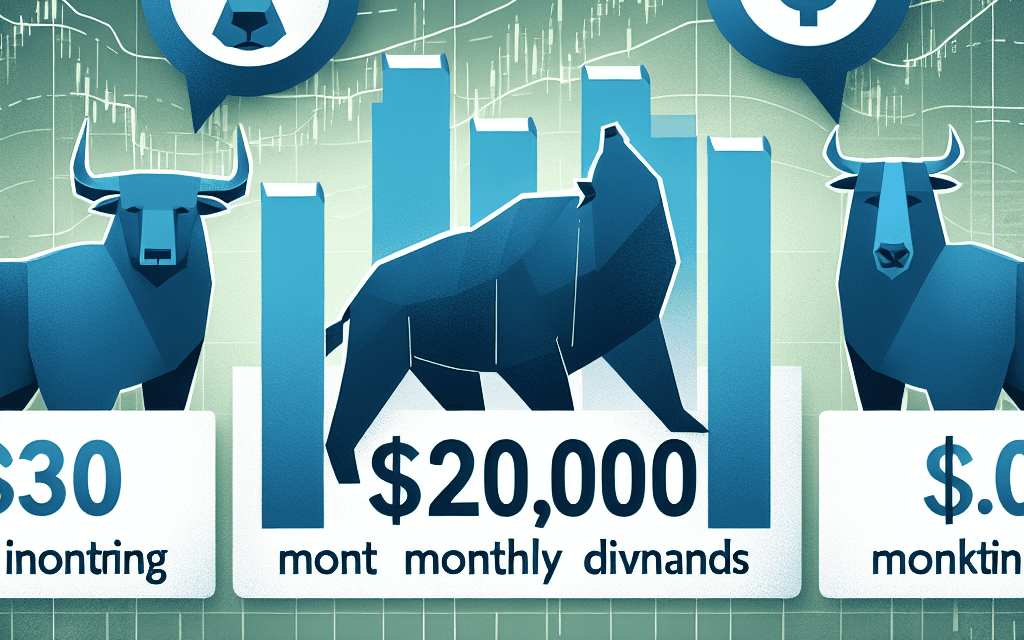“Turn $20,000 into a $300 Monthly Income Stream with These 3 Dividend Stocks!”
Introduction
Investing in dividend stocks can be a strategic way to generate a steady stream of passive income. By carefully selecting stocks with strong dividend yields and reliable payout histories, investors can potentially earn significant returns. In this guide, we explore how you can earn $300 monthly in dividends by investing $20,000 in a curated selection of three high-performing stocks. These stocks not only offer attractive dividend yields but also possess solid fundamentals and growth prospects, making them ideal candidates for income-focused investors seeking to enhance their financial portfolios.
Understanding Dividend Investing: A Path to Passive Income
Dividend investing is a strategy that has long been favored by those seeking a steady stream of passive income. By investing in companies that regularly distribute a portion of their earnings to shareholders, investors can enjoy a reliable income source without having to sell their shares. This approach not only provides financial stability but also allows for the potential growth of capital over time. For those looking to earn $300 monthly in dividends, investing $20,000 in a carefully selected portfolio of dividend-paying stocks can be an effective strategy.
To achieve this goal, it is essential to focus on companies with a strong track record of paying dividends and the potential for future growth. One such company is Johnson & Johnson, a stalwart in the healthcare sector. Known for its diverse range of products and services, Johnson & Johnson has consistently paid dividends for decades. Its robust financial health and commitment to returning value to shareholders make it an attractive option for dividend investors. By allocating a portion of the $20,000 investment to Johnson & Johnson, investors can benefit from its stable dividend yield and potential for capital appreciation.
Another promising candidate for dividend investing is Procter & Gamble, a leader in the consumer goods industry. With a portfolio of well-known brands and a global presence, Procter & Gamble has demonstrated resilience in various economic conditions. The company has a long history of increasing its dividend payouts, reflecting its strong cash flow and commitment to rewarding shareholders. By including Procter & Gamble in the investment portfolio, investors can tap into a reliable source of dividends while benefiting from the company’s growth prospects.
In addition to these established companies, it is also worth considering a utility company like NextEra Energy. As a leader in the renewable energy sector, NextEra Energy is well-positioned to capitalize on the global shift towards sustainable energy sources. The company has a solid track record of paying dividends and has consistently increased its payouts over the years. By investing in NextEra Energy, investors can not only earn dividends but also contribute to a more sustainable future.
When constructing a dividend-focused portfolio, diversification is key. By spreading the $20,000 investment across these three companies, investors can mitigate risk while maximizing their potential for earning $300 monthly in dividends. It is important to note that dividend yields can fluctuate based on market conditions and company performance. Therefore, regular monitoring and portfolio adjustments may be necessary to maintain the desired income level.
Furthermore, reinvesting dividends can enhance the compounding effect, leading to greater returns over time. By automatically reinvesting dividends into additional shares, investors can increase their ownership in these companies, potentially boosting future dividend income. This strategy not only accelerates wealth accumulation but also takes advantage of the power of compounding.
In conclusion, dividend investing offers a viable path to generating passive income. By carefully selecting companies with strong dividend histories and growth potential, investors can achieve their goal of earning $300 monthly in dividends with a $20,000 investment. Through diversification, regular monitoring, and reinvestment, this strategy can provide financial stability and long-term wealth growth. As with any investment approach, it is crucial to conduct thorough research and consider individual financial goals and risk tolerance before making investment decisions.
How to Choose Dividend Stocks for Consistent Returns
Investing in dividend stocks can be a strategic way to generate a steady stream of income, and with careful selection, it is possible to earn $300 monthly in dividends by investing $20,000 in the right stocks. To achieve this goal, it is crucial to understand the key factors that contribute to consistent returns from dividend stocks. By focusing on companies with a strong track record of dividend payments, a sustainable payout ratio, and robust financial health, investors can enhance their chances of securing reliable income.
First and foremost, a company’s history of dividend payments is a critical indicator of its commitment to returning value to shareholders. Companies that have consistently paid and increased dividends over the years demonstrate stability and a shareholder-friendly approach. These companies, often referred to as “dividend aristocrats,” have weathered various economic cycles and maintained their dividend policies, which can provide investors with confidence in their ability to continue doing so in the future. Therefore, when selecting dividend stocks, it is prudent to prioritize those with a long history of uninterrupted dividend payments.
In addition to a strong dividend history, the payout ratio is another essential factor to consider. The payout ratio, which is the percentage of earnings paid out as dividends, provides insight into the sustainability of a company’s dividend payments. A lower payout ratio suggests that a company retains a significant portion of its earnings for reinvestment or to cushion against economic downturns, thereby enhancing the likelihood of maintaining or increasing dividends. Conversely, a high payout ratio may indicate that a company is distributing most of its earnings as dividends, which could be unsustainable if earnings decline. Therefore, targeting companies with a moderate payout ratio can help ensure that dividends remain consistent over time.
Moreover, the financial health of a company plays a pivotal role in its ability to sustain dividend payments. Companies with strong balance sheets, characterized by low debt levels and ample cash reserves, are better positioned to weather economic uncertainties and continue paying dividends. Financially robust companies are also more likely to invest in growth opportunities, which can lead to increased earnings and, consequently, higher dividends in the future. Thus, evaluating a company’s financial statements and understanding its debt-to-equity ratio, cash flow, and profitability metrics are essential steps in selecting dividend stocks that offer consistent returns.
Furthermore, diversification across different sectors can mitigate risks associated with investing in dividend stocks. By spreading investments across various industries, investors can reduce the impact of sector-specific downturns on their dividend income. For instance, while the energy sector may face volatility due to fluctuating oil prices, the consumer staples sector might offer stability due to consistent demand for essential goods. Therefore, constructing a diversified portfolio of dividend stocks can enhance the reliability of monthly dividend income.
In conclusion, earning $300 monthly in dividends by investing $20,000 in stocks is achievable through a strategic approach to selecting dividend stocks. By focusing on companies with a strong dividend history, a sustainable payout ratio, and robust financial health, investors can increase their chances of securing consistent returns. Additionally, diversification across different sectors can further enhance the stability of dividend income. By adhering to these principles, investors can build a portfolio that not only generates reliable income but also offers the potential for long-term growth.
The Power of Reinvestment: Growing Your Dividend Income
Investing in dividend stocks is a time-tested strategy for generating a steady stream of income, and with the right approach, it can also lead to significant growth in your investment portfolio. By reinvesting dividends, investors can harness the power of compounding, which can exponentially increase their returns over time. For those looking to earn $300 monthly in dividends, a well-thought-out investment of $20,000 in select stocks can be a viable path. This approach not only provides immediate income but also sets the stage for future financial growth.
To achieve this goal, it is essential to focus on companies with a strong track record of paying dividends and the potential for future growth. Companies that consistently pay dividends often have stable earnings and a commitment to returning value to shareholders. By selecting stocks with a high dividend yield, investors can maximize their income potential. However, it is equally important to consider the sustainability of these dividends. Companies with a history of increasing their dividend payouts are particularly attractive, as they indicate financial health and a shareholder-friendly approach.
One such company that fits this criterion is a utility firm with a robust dividend yield and a history of consistent payouts. Utility companies are known for their stable cash flows, as they provide essential services that are always in demand. This stability allows them to offer attractive dividends, making them a cornerstone in many dividend-focused portfolios. By investing in a reliable utility stock, investors can secure a portion of their desired monthly income while benefiting from the company’s steady growth.
Another promising sector for dividend investors is consumer staples. Companies in this sector produce goods that are always in demand, regardless of economic conditions. This consistent demand translates into reliable revenue streams, which support regular dividend payments. A well-established consumer staples company with a strong brand portfolio and a commitment to returning capital to shareholders can be an excellent addition to a dividend-focused portfolio. Such companies often have a history of increasing their dividends, providing investors with both income and growth potential.
Finally, the technology sector, while traditionally known for growth rather than income, has seen an increasing number of companies offering dividends. A mature tech company with a solid market position and a history of dividend payments can provide both growth and income. These companies often have significant cash reserves, allowing them to reward shareholders while continuing to invest in innovation. By including a tech stock with a reliable dividend in their portfolio, investors can benefit from the sector’s growth potential while enjoying regular income.
Reinvesting dividends from these stocks can significantly enhance the growth of an investment portfolio. By automatically purchasing additional shares with the dividends received, investors can increase their holdings without additional capital outlay. Over time, this reinvestment strategy can lead to a substantial increase in both the number of shares owned and the total dividend income received. As the companies continue to grow and potentially increase their dividend payouts, the compounding effect becomes even more pronounced.
In conclusion, by carefully selecting stocks from stable sectors such as utilities, consumer staples, and technology, investors can achieve their goal of earning $300 monthly in dividends from a $20,000 investment. The key lies in choosing companies with a strong history of dividend payments and the potential for future growth. By reinvesting dividends, investors can further amplify their returns, harnessing the power of compounding to grow their income and wealth over time.
Analyzing Stock Performance: Key Metrics for Dividend Investors

When considering an investment strategy focused on generating a steady stream of income through dividends, it is crucial to analyze key performance metrics that can help identify stocks with the potential to yield consistent returns. For investors aiming to earn $300 monthly in dividends by investing $20,000, selecting the right stocks is paramount. This involves a thorough examination of several financial indicators that can provide insights into a company’s ability to sustain and grow its dividend payouts over time.
To begin with, the dividend yield is a fundamental metric that dividend investors should scrutinize. It represents the annual dividend payment as a percentage of the stock’s current price. A higher dividend yield can indicate a more attractive income opportunity; however, it is essential to balance this with the company’s overall financial health. For instance, a stock with an unusually high dividend yield might be compensating for underlying business challenges, which could jeopardize future payouts. Therefore, while a high yield is appealing, it should be considered alongside other financial metrics to ensure sustainability.
Another critical factor to evaluate is the payout ratio, which measures the proportion of earnings a company distributes as dividends. A lower payout ratio suggests that a company retains a significant portion of its earnings for reinvestment or to cushion against economic downturns, thereby enhancing its ability to maintain dividend payments. Conversely, a high payout ratio might indicate that a company is distributing most of its earnings, leaving little room for error if profits decline. Ideally, investors should look for companies with a moderate payout ratio, reflecting a balance between rewarding shareholders and maintaining financial flexibility.
Furthermore, the company’s historical dividend growth rate is an essential indicator of its commitment to increasing shareholder value. A consistent track record of dividend growth not only signals financial stability but also suggests that the company is confident in its future earnings potential. This growth can help investors keep pace with inflation, ensuring that the real value of their dividend income does not erode over time. Therefore, selecting stocks with a robust history of dividend increases can be a prudent strategy for long-term income generation.
In addition to these metrics, it is vital to consider the company’s overall financial health and market position. Analyzing the balance sheet for indicators such as debt levels and cash flow can provide a clearer picture of the company’s ability to sustain its dividend payments. Companies with strong cash flow and manageable debt are generally better positioned to weather economic fluctuations and continue rewarding shareholders.
Moreover, understanding the industry dynamics and competitive landscape in which a company operates can offer valuable context. Industries with stable demand and limited competition are often more conducive to reliable dividend payments. Therefore, investors should seek companies with a strong market presence and a competitive edge, as these factors can contribute to sustained profitability and, by extension, consistent dividends.
In conclusion, while the prospect of earning $300 monthly in dividends from a $20,000 investment is enticing, achieving this goal requires careful selection of stocks based on key performance metrics. By focusing on dividend yield, payout ratio, historical dividend growth, and overall financial health, investors can identify companies with the potential to provide a reliable income stream. This strategic approach not only enhances the likelihood of achieving desired returns but also mitigates risks associated with dividend investing.
Diversifying Your Portfolio: Balancing Risk and Reward
Diversifying your portfolio is a fundamental strategy for balancing risk and reward, especially when aiming to earn a steady income through dividends. By carefully selecting a mix of stocks, investors can achieve a reliable monthly income while mitigating potential risks. For those looking to earn approximately $300 monthly in dividends, investing $20,000 in a well-chosen trio of stocks can be an effective approach. This strategy not only focuses on dividend yield but also considers the stability and growth potential of the companies involved.
To begin with, selecting stocks with a strong track record of dividend payments is crucial. Companies that consistently pay dividends, even during economic downturns, often demonstrate financial stability and a commitment to returning value to shareholders. For instance, utility companies are traditionally known for their reliable dividend payouts. These companies provide essential services, ensuring a steady demand for their products regardless of economic conditions. By allocating a portion of your investment to a reputable utility stock, you can secure a portion of your monthly dividend income with relatively low risk.
In addition to utility stocks, incorporating a high-yielding real estate investment trust (REIT) can further enhance your portfolio’s income potential. REITs are required by law to distribute a significant portion of their earnings as dividends, making them an attractive option for income-focused investors. By investing in a diversified REIT that holds a variety of properties, such as commercial, residential, and industrial real estate, you can benefit from a stable income stream. Moreover, the real estate sector often acts as a hedge against inflation, providing an additional layer of security to your investment.
Furthermore, including a blue-chip stock with a history of dividend growth can add a dynamic element to your portfolio. Blue-chip companies are typically large, well-established firms with a reputation for reliability and performance. These companies often have the financial strength to not only maintain but also increase their dividend payouts over time. By investing in a blue-chip stock, you can potentially benefit from both capital appreciation and an increasing dividend income, thereby enhancing the overall return on your investment.
While focusing on dividend yield is important, it is equally essential to consider the overall financial health and growth prospects of the companies you choose. A high dividend yield may be enticing, but it can also be a red flag if the company is struggling financially. Therefore, conducting thorough research and analysis is vital to ensure that the stocks you select are not only capable of providing a steady income but also have the potential for long-term growth.
In conclusion, by diversifying your portfolio with a mix of utility stocks, REITs, and blue-chip companies, you can effectively balance risk and reward while aiming to earn $300 monthly in dividends from a $20,000 investment. This approach not only provides a stable income stream but also positions your portfolio for potential growth. As with any investment strategy, it is important to regularly review and adjust your holdings to align with your financial goals and market conditions. By doing so, you can maintain a well-balanced portfolio that continues to deliver value over time.
Tax Implications of Dividend Income: What You Need to Know
When considering the prospect of earning $300 monthly in dividends by investing $20,000 in select stocks, it is crucial to understand the tax implications associated with dividend income. Dividends, which are payments made by a corporation to its shareholders, can be a reliable source of passive income. However, they are subject to taxation, and understanding these tax obligations is essential for effective financial planning.
To begin with, it is important to distinguish between qualified and non-qualified dividends, as they are taxed differently. Qualified dividends are those paid by U.S. corporations or qualified foreign corporations and meet specific holding period requirements. These dividends benefit from being taxed at the lower long-term capital gains tax rates, which range from 0% to 20%, depending on your taxable income and filing status. In contrast, non-qualified dividends, also known as ordinary dividends, are taxed at the individual’s ordinary income tax rates, which can be significantly higher.
As you plan your investment strategy to earn $300 monthly in dividends, it is advisable to focus on stocks that pay qualified dividends. This approach can help minimize your tax liability and maximize your net income. However, it is also essential to consider the impact of your overall income level on the taxation of dividends. For instance, if your taxable income is relatively low, you may qualify for the 0% tax rate on qualified dividends, effectively allowing you to receive this income tax-free.
Moreover, it is important to be aware of the additional 3.8% Net Investment Income Tax (NIIT) that may apply to your dividend income. This tax is levied on individuals with a modified adjusted gross income (MAGI) above certain thresholds—$200,000 for single filers and $250,000 for married couples filing jointly. If your income exceeds these thresholds, the NIIT could further impact the net return on your dividend investments.
In addition to federal taxes, state taxes can also affect your dividend income. Each state has its own tax regulations, and some states may tax dividends at the same rate as ordinary income, while others may offer more favorable rates. It is crucial to understand the specific tax laws in your state of residence to accurately calculate your after-tax dividend income.
Furthermore, for those investing through tax-advantaged accounts such as a Roth IRA or a traditional IRA, the tax implications differ. Dividends earned within a Roth IRA are generally tax-free, provided certain conditions are met, while those in a traditional IRA are tax-deferred until withdrawal. Utilizing these accounts can be a strategic way to manage the tax burden associated with dividend income.
In conclusion, while investing $20,000 in stocks to earn $300 monthly in dividends can be an attractive financial goal, it is imperative to consider the tax implications of such income. By understanding the differences between qualified and non-qualified dividends, being mindful of your overall income level, and considering the impact of state taxes and tax-advantaged accounts, you can effectively plan to maximize your net dividend income. This comprehensive approach will ensure that you are well-prepared to navigate the complexities of dividend taxation and achieve your financial objectives.
Long-Term Strategies for Maximizing Dividend Earnings
Investing in dividend stocks is a time-tested strategy for generating a steady stream of income, and with careful selection, it is possible to earn $300 monthly in dividends by investing $20,000 in a diversified portfolio. This approach not only provides regular income but also offers the potential for capital appreciation over the long term. To achieve this goal, it is essential to focus on companies with a strong track record of dividend payments, robust financial health, and the potential for future growth. By strategically allocating your investment across three carefully chosen stocks, you can maximize your dividend earnings while minimizing risk.
First and foremost, consider investing in a utility company known for its stable cash flows and consistent dividend payouts. Utility companies typically operate in regulated industries, providing essential services such as electricity, water, and natural gas. This stability allows them to offer reliable dividends to shareholders. For instance, a well-established utility company with a dividend yield of around 4% can be an excellent addition to your portfolio. By investing approximately $6,700 in such a company, you can expect to receive around $22 monthly in dividends, contributing significantly to your $300 monthly target.
In addition to utilities, the consumer staples sector offers another promising avenue for dividend investors. Companies in this sector produce essential goods such as food, beverages, and household products, which remain in demand regardless of economic conditions. This resilience makes them attractive for dividend-seeking investors. A leading consumer staples company with a dividend yield of about 3.5% can provide both stability and growth potential. Allocating another $6,700 to a company in this sector can yield approximately $20 monthly in dividends, further enhancing your income stream.
Moreover, the healthcare sector presents a compelling opportunity for dividend investors. With an aging global population and increasing demand for medical services, healthcare companies are well-positioned for long-term growth. Many established firms in this sector offer attractive dividend yields while maintaining strong financial health. By investing the remaining $6,600 in a reputable healthcare company with a dividend yield of around 3.5%, you can expect to receive an additional $19 monthly in dividends. This investment not only contributes to your monthly income but also provides exposure to a sector with significant growth potential.
To ensure the success of this strategy, it is crucial to conduct thorough research and due diligence before selecting stocks. Evaluate each company’s financial statements, dividend history, and growth prospects. Additionally, consider the broader economic environment and any potential risks that may impact the sectors you are investing in. Diversification across different industries can help mitigate risks and enhance the stability of your dividend income.
Furthermore, reinvesting dividends can accelerate the growth of your portfolio over time. By reinvesting the dividends you receive, you can purchase additional shares, thereby increasing your future dividend income. This compounding effect can significantly boost your long-term returns and help you achieve your financial goals more quickly.
In conclusion, earning $300 monthly in dividends by investing $20,000 is an attainable objective with a well-diversified portfolio of utility, consumer staples, and healthcare stocks. By focusing on companies with strong dividend yields and growth potential, you can create a reliable income stream while positioning yourself for future capital appreciation. Through careful research, diversification, and reinvestment, you can maximize your dividend earnings and build a robust financial foundation for the future.
Q&A
1. **What is the average dividend yield needed to earn $300 monthly from a $20,000 investment?**
– To earn $300 monthly, or $3,600 annually, from a $20,000 investment, you need an average dividend yield of 18%.
2. **Which sectors are typically known for high dividend yields?**
– Sectors like utilities, real estate investment trusts (REITs), and energy are typically known for high dividend yields.
3. **What is a key factor to consider when selecting dividend stocks?**
– A key factor is the sustainability of the dividend, which can be assessed by looking at the payout ratio and the company’s financial health.
4. **Name a stock known for high dividend yields.**
– Altria Group, Inc. (MO) is known for offering high dividend yields.
5. **What is a potential risk of investing in high-yield dividend stocks?**
– A potential risk is that high yields can sometimes indicate financial instability or declining stock prices.
6. **How can dividend reinvestment impact earnings?**
– Dividend reinvestment can compound earnings over time, increasing the total return on investment.
7. **What is a dividend aristocrat?**
– A dividend aristocrat is a company that has consistently increased its dividend payout for at least 25 consecutive years.
Conclusion
Investing $20,000 in a diversified portfolio of three carefully selected dividend-paying stocks can potentially yield $300 in monthly dividends, assuming an average annual dividend yield of around 18%. This strategy requires choosing stocks with a strong track record of consistent dividend payments and financial stability. However, investors should be aware of the risks involved, including market volatility and changes in dividend policies, and should consider their own risk tolerance and investment goals. Diversification and regular portfolio reviews are essential to maintaining and potentially increasing dividend income over time.





